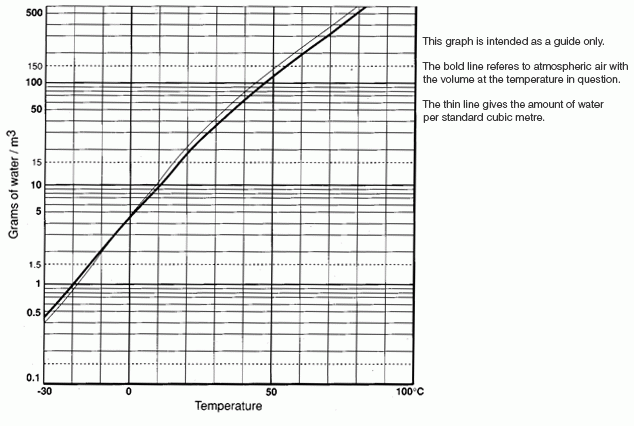
SMC authorised dealer
Do you looking for SMC Pneumatic products !!!?
SMC authorised dealer..............
Please call Gentle Automatic Solution Sdn Bhd , we have speciallist to guard you.
Tel: 03-80237743 / 8743 Fax:03-80239743 or
email: sales@gentle.com.my will give a sales advise and consult on this products and application.
| |
Dew Point & Relative Humidity |
|
|
|
|
|
|

|
| |
Atmospheric air contains a proportion of moisture, which is released when the air is cooled. In a pneumatic system, this occurs when compressed air is delivered from the compressor to downstream equipment.
The terms which are most often applied in this context are dew point and relative humidity. |
|
|
|
| The amount of water vapour contained in air is directly proportional to its temperature, not, as is commonly supposed, to its pressure. |
|
As air cools the water vapour within it condenses, reaching the temperature where the air becomes saturated; this is called the dew point. If the temperature drops, additional moisture is liberated in the form of tiny droplets or
condensation. Natural examples of atmospheric dew point (ADP°C) can be seen where warm air has come into
contact with cold surfaces, typically forming condensation on window panes or early morning dew, where warm air at ground level meets a descending cold air mass. |
|
| The term atmospheric dew point is most relevant to weather conditions. In compressed air installations and pneumatic systems, pressure dew point is more appropriate. |
|
| Pressure dew point (PDP °C) is the temperature at which condensation occurs at elevated pressure; typically 7 bar is used as this is the most common compressed air system pressure in general use. |
|
| The actual quantity of water which air is capable of retaining in suspension is dependent on temperature, so one cubic metre of air at 7 bar will hold the same amount of water as one cubic metre at 1 bar. |
|
| The table below shows the number of grams of water which one cubic metre of air is capable of supporting at different temperatures; values are given for atmospheric and pressure dew points. |
|
 |
|
|
| Relative Humidity (RH) is the ratio between the actual water vapour content of a volume of air to the maximum water vapour content at a given temperature. |
|
| RH (%) = (Actual water content/Maximum water content) x 100 |
|
| RH is usually expressed as a percentage. However care must be taken in using this term as it can be misleading due to temperature variations within any system. |
|
| To look at relative humidity, we will follow the progress of lm3 of air during compression. |
|
| From the chart below; lm3 of atmospheric air can support 17g of water vapour @ 20°C. |
|
 |
| For the UK, assuming an average humidity of 65%, the compressor would, therefore, draw in 11g of moisture with each lm3 of air. This would equate to the following: |
| Atmospheric Dew Point ADP °C = +20 |
| Pressure Dew Point (1 barg) PDP °C = +20 |
| By compressing the air to 7 bar g the temperature would rise dramatically; 100°C would be typical. |
| 1m3 of air at 7 bar g = 8m3 of atmospheric air. |
| The actual moisture content of 1m3 at 7 bar g can be calculated as follows: |
| |
17g x 65% x 8m3 = 90g |
| |
Pressure Dew Point at 7 barg = +100°C |
| |
Relative Humidity = 15% |
| To reduce the air temperature, an aftercooler is usually fitted to the system. This would result in a temperature decrease to +35°C (approx). |
| lm3 of air at 35°C can only support 40g of water vapour of the 90g drawn in by the compressor. 50g appears as condensed free water needing to be drained from the system. The air condition at this stage would be: |
| |
Pressure Dew Point +35°C (40g of water) |
| |
Relative Humidity 100% |
| Assuming an ambient temperature of +20°C, lm3 of air can only support 17g of the 40g left in the system by the aftercooler, a further 23g will be released into downstream receivers, pipework and pneumatic equipment. This would result in an air condition of: |
| |
Pressure Dew Point +20°C (17g of water) |
| |
Relative Humidity 100% |
| Any further reduction in temperature, such as outside pipe work, will result in further condensation of water vapour and extra free water in the system. Installation of drying equipment will further reduce the water vapour content. |
| The following are the three main types of compressed air drying equipment: |
| |
Deliquescent |
| |
Refrigerant |
| |
Desiccant |
| Shown below are the dew points, RH values and water vapour contents achieved for each type of dryer: |
| Deliquescent dryers reduce the moisture content chemically and at an ambient temperature of +20°C, a pressure dew point of approximately +16°C can be achieved with a water vapour content of 13g/m3. The relative humidity would be 80%. |
| A refrigerant type unit would reduce the air temperature to between +3°C and +7°C resulting in a maximum water vapour content of 7g/m3. |
| |
Pressure Dew Point +7°C |
| |
Relative Humidity 44% |
| Desiccant dryers reduce the moisture content chemically to the equivalent of -40°C, giving a maximum moisture vapour content of 0.12g/m3. |
| |
Pressure Dew Point -40°C |
| |
Relative Humidity 0.7% |
| Pressure dew points of as low as -70°C can be achieved forspecial applications. |
|
|
|



